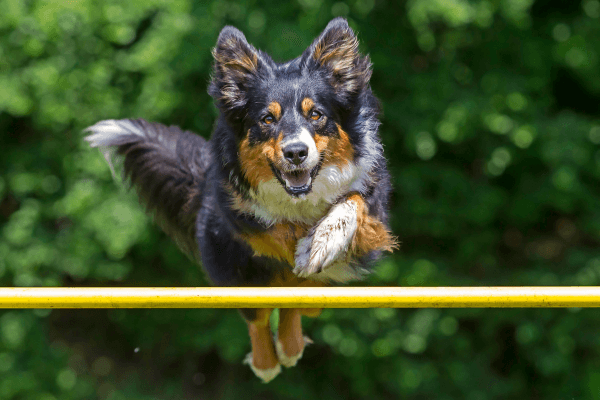If you're looking for a way to give back to your local community and make a difference in the lives of others, training your dog to become a therapy dog is the “ultimutt” way!
Not quite ready to train your pup as a therapy dog? No worries, your pooch can still make a difference in your local community!
Find borrowers in your area who would love to spend time with your dog
Dogs have been shown to be incredibly effective in providing comfort and support to people in many situations.
In the UK, many organisations allow therapy dogs into hospitals, care homes, and schools. It can be a pawsitively rewarding experience to know that your dog is making a difference in people's lives.
In this article, we will discuss the process of training your dog to become a therapy dog. We will also provide information on the different organisations that allow therapy dogs in the UK.
Overview of article
- What is a therapy dog?
- How to train your pup to become a therapy dog
- Registering as a therapy dog
- Tips for working with a therapy dog
- Pets as Therapy
- Testimonials of our members
- Where can I take my therapy dog?
What is a therapy dog and what do they do?
In short, a therapy dog is a trained pet dog that provides comfort and support to people in hospitals, schools, retirement homes, and other settings.
These proud pups are often used in programs such as animal-assisted therapy, which has been shown to improve physical and mental health outcomes.
Therapy dogs can:
- provide unconditional love
- provide companionship
- help ease anxiety
- help ease stress
- boost self-esteem
Therapy dogs are devoted doggos that bring joy and happiness wherever they go. From wagging tails to sloppy kisses, therapy dogs have the ability to make even the gloomiest of days just a little bit brighter.
But don’t fur-get the serious side to having a therapy dog! Therapy dogs typically undergo a rigorous training program that helps them to remain calm and focused in a variety of settings. They also learn how to safely interact with people of all ages and abilities.
Difference between a therapy dog and an assistance dog
But what’s the difference between a therapy dog and an assistance dog I hear you ask. Well, an assistance dog is focused on just one person and has been taught to do a variety of set tasks and actions for this person. While a therapy dog is often a pet dog who helps a variety of people in the local community (together with its volunteer/owner).
For more information on assistance dogs, read our guide on why you can't pet an assistance dog and visit the Assistance Dogs UK.

How to train your dog to be a therapy dog
Training your dog to be a therapy dog is a pawsitively rewarding experience! With a little training, your four-legged companion can join the ranks of these certified cuddle machines.
First, you'll want to make sure that your dog has a good temperament and is comfortable around people.
Then, you'll need to begin training basic commands such as sit, stay, come, and down. Read our dog training tips to get ahead!
Good Citizen Dog Training Scheme
Once your pup has mastered these basics, we suggest that you sign up for the KC Good Citizen Dog Training scheme at your local dog training club. It is advised by Therapy Dogs Nationwide that your pup reaches the Bronze award (or equivalent) standard of the KC GCDS (Kennel Club Good Citizen Dog Scheme). So that means passing Puppy Foundation training first and then moving on to the Bronze scheme. There’s a silver and gold level as well, but bronze should be sufficient for a temperament assessment.
Temperament Assessment
Once your dog passes their Bronze scheme test with flying colours, he or she will be ready to start making a difference in the lives of others!
Usually the organisation you will be volunteering at, will want to do a temperament assessment.
Now what exactly does that entail?
What your pup will need to be able to do:
- Walk on a relaxed lead, without lots of tugging and pulling to show that they are under the owner’s full control at all times.
- Allow to be stroked and have their tail, paws and ears checked by another person because therapy dogs will often be patted by patients and other ‘strangers’. Top tip: make sure your doggo’s nails are kept nice and short!
- Take a treat gently because patients love to give the visiting therapy dogs a treat
- React appropriately to a sudden event or noise because therapy dogs may encounter new experiences and smells/noises without worrying them too much.
Tips for training your therapy dog
Training a therapy dog can be a lot of work, but it's also a lot of fun. After all, what's more rewarding than seeing your furry friend make someone's day a little brighter? Here are a few things to keep in mind when training your dog to be a therapy dog:
- It's important to start training early. The sooner you start, the better.
- Be patient. Training a therapy dog takes time and patience. There will be ups and downs, but if you're consistent, you'll eventually see progress.
- Keep it fun. Make sure to incorporate plenty of playtime and positive reinforcement into the training process. This will help your dog stay motivated and engaged.
- Seek professional help. If you're struggling, don't hesitate to seek out professional help from a qualified trainer or behaviourist. They can offer valuable insights and guidance that can make the training process much easier.
How to get your dog registered as a therapy dog
If you're looking for a way to get your dog registered as a therapy dog, there are a few things you'll need to do.
- First, you'll need to make sure your dog is up to date on all of his or her vaccinations.
- You'll also need to have a recent photo of your dog, as well as proof of liability insurance.
- Once you have all of the necessary paperwork, you can begin the application process. The first step is to find a therapy dog organisation and fill out an application form.
- Once your application has been reviewed and approved (which usually includes passing a brief screening process), you'll be able to take the next step and register your dog as a therapy dog.
With a little bit of work, you can have your furry friend registered and ready to provide therapy to those in need.
Once your dog is registered, you'll be able to start taking them to visit locations such as hospitals, nursing homes, and schools. And who knows? You might just make a few new friends along the way.
Tips for working with your therapy dog
The first step in training your dog to be a therapy dog is to make sure that they are well-suited for the job.
Therapy dogs must be calm, gentle, and loving. They should also be comfortable around different people and animals. If your dog meets these criteria, then they may be a good candidate for therapy work.
The next step is to begin training your dog in basic obedience commands. This is important because therapy dogs must be able to follow instructions from their handlers. Once your dog has a good understanding of basic obedience commands, you can start working on specific therapy dog tasks. These tasks may include sitting calmly while being petted, lying down next to someone in a wheelchair, or fetching a blanket for someone who is feeling cold.
It is important to remember that therapy dogs are not service animals, and they should not be asked to perform tasks that would be considered dangerous or stressful.
Once you have decided that your dog is ready to begin therapy work, the next step is to find an organisation that allows therapy dogs in the UK. There are many organisations that allow therapy dogs into hospitals, care homes, and schools. The best way to find an organisation that is right for you and your dog is to do some research online or have a look through our list below.
Therapy work can be very rewarding for both you and your dog. It is a great way to give back to your community and make a difference in the lives of others. If you think that your dog has what it takes to become a therapy dog, then we encourage you to begin the training process today!

Pets As Therapy
We asked our friends at Pets As Therapy to tell us more about their work:
Who are Pets As Therapy?
Pets As Therapy is a charity which is committed to enriching people’s lives through the powerful impact that can come from our relationships with animals.
What do Pets As Therapy do?
It’s a really simple model, we provide therapeutic pet visits. Through a network of volunteers across the country, we visit a range of places including hospitals, schools, palliative care units, prisons and residential care homes. We spend time with people, providing the opportunity for them to spend time with a behaviourally assessed pet dog or cat.
Why do you do the work you do?
We know we can’t fix the world, but each and every day our PAT visits are making a difference to people’s lives. This is one example of how our visits help people:
One of our PAT teams visit a Stroke recovery and dementia ward, they assist physiotherapists and speech therapists with the rehabilitation of patients. Stroke patients are encouraged to walk through the ward with the PAT dog to help them learn to walk again. The volunteer and their dog work closely with speech therapists to help stroke and other patients who cannot speak, as part of their rehabilitation. As part of this therapy, the speech therapist will encourage the patient to say the name of the dog. In one example, a patient who could only say one word and was not able to put together sentences, was encouraged to say the name of the dog, which was Kimmy. He tried this during the session but was unable to do so. At the end of the session as the volunteer, their dog and the therapist were walking away, the patient said, ‘bye Kimmy’. This was the first time that the patient had spoken more than one word clearly.
Could you and your dog be a visiting PAT team?
We’ve got a huge waiting list of places that want a PAT team, so we’re always looking for new volunteers. We’re looking for people with a dog or cat with a great temperament who are able to make a regular volunteering commitment (it doesn’t have to be once a week, it can be once a month or once a fortnight, etc).
There's good evidence that therapy dogs are very beneficial for students - one study found that 80.7% of students reported a drop in stress when working with PATs.
PAT pets come in all shapes and sizes and can be a pedigree or a crossbreed. PAT pets need to be friendly and calm, healthy and well-groomed, and love being fussed. Your pets must be at least 9 months old and you must have known them for at least 6 months. They also need to have up-to-date vaccinations and have regular worming and flea treatments.
Not sure you and your dog are ready?
Not to worry if your canine chum isn't quite ready to join the PAT team, BorrowMyDoggy can be a great way to start spreading pawprints of happiness on the lives of others.
Find borrowers in your area who would love to spend time with your dog
Testimonials
See what some of our members have to say about the impact this makes to their lives:
Rosie's owner, Merilyn from Oxford says:
I know that Rosie is in safe hands and having the exercise she needs. I discovered that Rosie is a therapy for many walkers, lonely students, folk suffering from depression and others who simply want not to walk alone. I would unreservedly recommend BorrowMyDoggy to dog owners.

Monty's borrower, Kay from Kent says:
I lost my lovely Harry in February. I live alone and was so lost not only missing him desperately but also my way of life which was lots of country walking. I joined as a borrower and am now walking the lovely Monty, I call him my therapy dog! I’m helping him and vice versa.

Find borrowers in your area who would love to spend time with your dog





